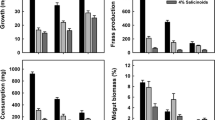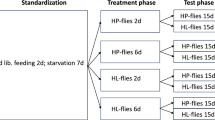Abstract
Schistocerca americanasixth-instar nymphs were examined for a change in diet acceptance, in which insects experiencing an unfavorable diet subsequently become predisposed to eat relatively less of that diet and more of diets with a novel flavor than they would had they previously fed on a more adequate diet. Insects were pretreated for 4 h on either low-protein (2 % wet wt) or higherprotein (4%) artificial diets flavored with a plant secondary compound (tomatine or rutin). They were then offered, in choice or no-choice tests, the lowprotein diet with the familiar or a novel (tomatine, rutin, or NHT) flavor. When tomatine was the familiar and rutin the novel flavor in a no-choice test, the insects previously fed low-protein diets took relatively long meals on the novel and relatively short meals on the familiar diets compared with the insects that had previously eaten higher-protein diets. A similar, but in this case considerably less pronounced and statistically nonsignificant, pattern existed in the reciprocal design experiment in which rutin was the familiar and tomatine the novel flavor. Similarly, insects fed low-protein diets flavored with rutin subsequently showed an increased relative preference for the novel flavor (NHT) in a choice test, compared with the high protein-pretreated insects. It is concluded that insects fed protein-deficient diets may subsequently show a preference for novel foods through different mechanisms, the importance of which may differ in different circumstances.
Similar content being viewed by others
References
Abisgold, J. D., and Simpson, S. J. (1987). The physiology of compensation by locusts for changes in dietary protein.J. Exp. Biol. 129: 329–346.
Abisgold, J. D., and Simpson, S. J. (1988). The effect of dietary protein levels and haemolymph composition on the sensitivity of the maxillary palp chemoreceptors of locusts.J. Exp. Biol. 135: 215–229.
Bernays, E. A., and Lee, J. C. (1988). Food aversion learning in the polyphagous grasshopper,Schistocerca americana.Physiol. Entomol. 13: 131–137.
Bernays, E. A., Howard, J. J., Champagne, D., and Estesen, B. (1991). Rutin: A phagostimulant for the polyphagous acrididSchistocerca americana. Entomol. Exp. Appl. (in press).
Champagne, D., and Bernays, E. A. (1991). Phytosterol unsuitability as a factor mediating food aversion learning in the grasshopperSchistocerca americana. Physiol. Entomol. (in press).
Cohen, R. W., Friedman, S., and Waldbauer, G. P. (1987). Physiological control of nutrient selfselection inHeliothis zea larvae: the role of serotonin.J. Insect Physiol. 34: 935–940.
Cook, A. G. (1976). A critical review of the methodology and interpretation of experiments designed to assay the phagostimulatory activity of chemicals to phytophagous insects.Symp. Biol. Hung. 16: 47–54.
Geissler, T. G., and Rollo, C. D. (1988). The influence of nutritional history on the response to novel food by the cockroachPeriplaneta americana.Anim. Behav. 35: 1905–1907.
Heinrichs, S. C., Deutch, J. A., and Moore, B. O. (1990). Olfactory self-selection of proteincontaining foods.Physiol. Behav. 47: 409–413.
Hunter-Jones, P. (1961).Rearing and Breeding Locusts in the Laboratory, Anti-Locust Research Centre, London.
Lee, J. C., and Bernays, E. A. (1988). Declining acceptability of a food plant for the polyphagous grasshopperSchistocerca americana: The role of food aversion learning.Physiol. Entomol. 13: 291–301.
Lee, J. C., and Bernays, E. A. (1990). Food tastes and toxic effects: Associative learning by the polyphagous grasshopperSchistocerca americana (Drury) (Orthoptera: Acrididae)Anim. Behav. 39: 163–173.
McFarland, D. (1985).Animal Behavior, Benjamin Cummings, Menlo Park, Calif.
Raubenheimer, D., and Simpson, S. J. (1990). The effects of simultaneous variation in protein, digestible carbohydrate and tannic acid on the feeding behaviour of larvalLocusta migratoria (L.) andSchistocerca gregaria (Forskal). I. Short-term studies.Physiol. Entomol. 15: 219–223.
Rozin, P. (1976). The selection of foods by rats, humans and other animals. In Rosenblatt, J. S., Hinde, R. A., Shaw, E., and Bear, C. (eds.),Advances in the Study of Behavior, Vol. 6, Academic Press, New York, pp. 21–76.
Simpson, S. J., and Abisgold, J. D. (1985). Compensation by locusts for changes in dietary nutrients: Behavioural mechanisms.Physiol. Entomol. 10: 443–452.
Simpson, S. J., and Simpson, C. L. (1990). The mechanisms of nutritional compensation by phytophagous insects. In Bernays, E. A. (ed.),Insect-Plant Interactions, Vol. II, CRC Press, Boca Raton, Fla., pp. 111–160.
Simpson, S. J., and White, P. (1990). Associative learning and locust feeding: Evidence for a “learned hunger” for protein.Anim. Behav. 40: 506–513.
Simpson, S. J., Simmonds, M. S. J., Blaney, W. M., and Jones, J. P. (1990). Compensatory dietary selection occurs in larvalLocusta migratoria but notSpodoptera littoralis after a single deficient meal duringad libidum feeding.Physiol. Entomol. 15: 235–242.
Waldbauer, G. P., and Friedman, S. (1988). Dietary self-selection in insects. In Sehnal, F., Zabza, A., and Denlinger, D. L. (eds.),Frontiers in Physiological Insect Ecology, Wroclaw Technical University Press, Wroclaw, pp. 403–442.
Author information
Authors and Affiliations
Rights and permissions
About this article
Cite this article
Bernays, E.A., Raubenheimer, D. Dietary mixing in grasshoppers: Changes in acceptability of different plant secondary compounds associated with low levels of dietary protein (Orthoptera: Acrididae). J Insect Behav 4, 545–556 (1991). https://doi.org/10.1007/BF01048069
Accepted:
Issue Date:
DOI: https://doi.org/10.1007/BF01048069




